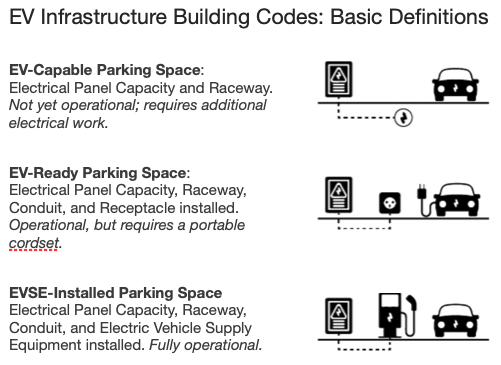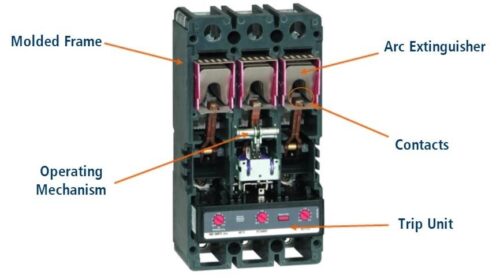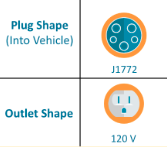
Glossary of Terms
Use page search functions to find a specific term.
Macs: “Command” + “F”
PCs: “CTRL” + “F” on PCs
Most common method for charging EVs as it is used by both level 1 and level 2 chargers. AC chargers are often found in homes, workplaces, and public locations.
Help determine who can use the electric vehicle (EV) chargers and at what times. This feature ensures secured charging at un-secured parking lots.
Distance an electric vehicle (EV) can travel on a full charge.
Vehicles that are only powered by an electric battery.
The cord that connects an electric vehicle (EV) to a charging station.
When a parking space has electrical panel capacity and raceway (or conduit), but a breaker, wiring and EV charger or outlet are not yet installed. This setup is not operational until wiring and an EV charger or outlet have been installed.
Funds used by a company to buy, maintain or upgrade its assets.
The dynamic coordinated control of electric vehicle (EV) charging to mitigate the challenges of costly upgrades and delayed EV charging station deployment due to a lack of distribution grid capacity.
A company or entity that builds, maintains, and operates electric vehicle (EV) charging stations.
A service provided by electric vehicle (EV) charging companies to test the equipment to ensure it follows safety standards and regulations before use.
When fixed fees from all chargers are added up, then divided by the number of residents using EV charging with the resulting amount added as an additional expense on rent bills.
Charging rent often aligns with a charging cost per kilowatt hour (kWh) being less than $0.05/kWh above the price property management pays the utility on an averaged per kWh basis. Any profit-motivated markups can be added into the charging rent pool of fees, or can be part of the small markup per kWh.
CaaS simplifies EV charging processes by offering access to EV charging infrastructure without the EV owner needing to manage or own any of the EV charging equipment.
CaaS simplifies EV charging processes by offering access to EV charging infrastructure without the EV supply equipment (EVSE) host needing to manage or own EV Charging equipment. CaaS contracts usually involve no upfront costs to the host site and guarantee the EV service provider (EVSP) a long-term exclusivity agreement for a set number of years. The EVSP sets the rates and can require a specific pricing business model. Electric vehicle supply equipment (EVSE), EV charger networking, billing services, and EVSE maintenance and support for owners or users are some of the potential service options CaaS providers offer to customers.
Parking spaces that are used only while an EV is charging.
A system of electrical circuits. For EV chargers, circuitry typically includes a circuit breaker wired to only a single outlet or electric vehicle supply equipment (EVSE) unit.
See Low Carbon Fuel Standard.
Steel or aluminum tubing used to route and protect electrical wiring.
(Property management perspective) Dollar per kilowatt hour (kWh) of energy used. Knowing the cost per kWh average helps to set prices to cover electricity costs. Use historical estimates or estimate and adjust prices over time.
Equation: Divide total cost of electric utility bill by number of kWhs used.
(Total cost of electric utility bill) 
An energy management strategy that adjusts electricity usage to balance supply and demand, often in response to grid needs or price signals.
Relationship to EV Charging: EV charging is a prime candidate for demand response (DR) because it can significantly impact electricity demand. DR programs can:
- Shift Charging: Encourage EVs to charge during off-peak hours, reducing grid stress.
- Leverage Renewables: Align charging with periods of high renewable energy availability, like midday solar peaks.
- Stabilize the Grid: Manage charging loads dynamically to enhance grid reliability.
- Enable Vehicle-to-Grid (V2G): Use EVs as energy sources during high-demand periods.
By optimizing when and how EVs charge, DR reduces costs, integrates cleaner energy, and enhances grid efficiency.
A charger that enables rapid charging by delivering direct-current (DC) electricity directly to an EV’s battery. DCFC equipment offers rapid charging along heavy-traffic corridors at installed stations.
DCFC equipment can charge a battery electric vehicle (BEV) to 80 percent in just 20 minutes to 1 hour. Most plug-in electric vehicles (PHEVs) currently do not work with fast chargers. Learn more about DCFCs here.
Electric vehicle (EV) chargers assigned for specific people or a specific deeded parking space. Typically only accessible to the resident or owner.
Contains circuit breakers and distributes electricity throughout the building through electrical wiring.
Either a fully battery electric vehicle (BEV) that relies on electric charged batteries alone, or a plug-in hybrid vehicle powered by both an electric charged battery and gasoline. In both EV types, batteries are charged by electricity at an EV charging station.
EV charging stations, EV charging outlets, or EV charging ports.
A collection of tools, software, and hardware that monitors, analyzes, and controls energy usage within a building or facility.
EMS optimizes energy consumption, identifies inefficiencies, and implements strategies to reduce energy costs while maintaining operational performance. EMS manages energy usage across a system by tracking, analyzing, and optimizing energy flows.
A parking spot with just the infrastructure (conduit, breaker space, junction box, etc.) for the future installation of an EV charging station. These types of spaces do not require any charging equipment to be installed at the time of permit.

Image. EV Infrastructure Building Codes: Basic definitions (Plug In America)
A few steps beyond EV capable, but there still is no EV charger installed. With EV-ready, all required infrastructure is installed, including the wires and circuit breakers. The circuit may be terminated in a junction box or to a receptacle.EV-ready includes everything needed to power an EV charger except for the charger itself. Learn more about EV ready parking spots here. Learn more about EV-ready building codes here.
EV-ready includes everything needed to power an EV charger except for the charger itself. Learn more about EV ready parking spots here.

Image. EV Infrastructure Building Codes: Basic definitions (Plug In America)
EV chargers that are available to any EV that is allowed to park in the parking lot and are available to any and all EVs that want to charge.
Ensuring a building has the infrastructure and electrical load capacity to meet the rising demand for electric vehicle charging.
This can be done through:
- Becoming capacity-ready by installing transformers and panel capacity for future EV chargers
- Including EV-readiness into state and local building codes
- Becoming EV-ready by installing switchgear, conduit, and wiring for chargers or outlets
- Providing EV charging options now
- Considering future load needs
Learn more about future-proofing and EV-readiness at the AFDC website. Learn more about the benefits of future-proofing here (SWEEP study).
Independent entities that administer a wider range of affordable housing and community development programs.
Fees imposed on an electric vehicle in an EV charging parking spot once charging is complete, or soon after. Idle fees effectively incentivize EV charging parking turnover and prevent chargers from being physically blocked by fully charged vehicles.
Considerations for implementing Idle Fees:
- Idle fee rates should be reasonable and not punitive
- Pilot a trial period prior to enforcing idle fees
- Only impost idle fees if a well-functioning notification system is in place
- Turn off idle fees overnight to avoid residents having to move EVs overnight if chargers are only available to residents through access controls (see definition above).Consider deactivating idle fees between the hours of 11:00 pm and 6:30 am, or earlier.
- Assessing a fee for time rather than energy dispensed should be avoided. If cars are occupying the parking spot without charging, update residents that policy changes may occur. If parking without charging continues, consider adding more chargers, or impose idle fees.
- Allow a grace period of at least 10 minutes before idle fees take effect. Some chargers have idle fees built-in to activate immediately after charging complete, but will remove the charge if the EV is moved within the following 10 minutes.
A unit of measure for energy usage. For reference, a microwave oven or a hair dryer uses about one kW.
A unit of energy over time. One kWh is equal to 1,000 watts of power for one hour of time. kWhs are the energy an electric vehicle uses instead of gasoline. Most long-range EVs have between 60 and 100kWh of energy within their batteries.
EV chargers with the lowest level of charging power and speed. L1 charging provides power through a common 120-volt (120V) outlet. Level 1 chargers can take 40-50+ hours to charge a battery electric vehicle (BEV) to 80% from empty and 5-6 hours for a plug-in electric vehicle (PHEV). L1 charging is a great, low power charging option for charging at home.
Level 2 charging offers higher power charging through a 240V (in residential applications) or 208V (in commercial applications) outlet; the same outlet a household dryer uses. L2 charging is common for home, workplace, and public charging. Level 2 chargers can charge a battery electric vehicle (BEV) to 80 percent from empty in 4-10 hours and a plug-in electric vehicle (PHEV) in 1-2 hours.
A passenger car or truck weighing less than 8,500 lbs as defined by the U.S. Environment Protection Agency (EPA).
The practice of controlling the demand on the electrical grid to prevent overloads, manage peak energy consumption, and ensure efficiency. Load management works best with an increased amount of amperage spread out over many chargers within an assigned-dedicated parking-charging configuration. Load management is not recommended for changing setups where it is not possible to cover the cost for EV-ready parking spaces.
Several EV chargers need not be installed if there are currently no EV-driving residents. One EV charger should be sufficient as long as prospective residents are aware that the amenity exists and can be scaled based on demand. If EV-Ready equipment has been installed, notify the new property owners about the equipment upon selling the property.
Learn more about load management here (Charge at Home partners do not endorse specific EVCI installers, EVSE brands or EVCI software).
Government programing with the purpose of decreasing the average carbon intensity of transportation fuels by requiring fuel producers to meet specific carbon emission targets, while enabling credit generation based on dispensing low-carbon fuels for transportation purposes.
Also referred to as Clean Fuels Programs.
The pre-wiring of electrical infrastructure at a parking space to facilitate easy and cost-efficient installation of electric vehicle supply equipment (EVSE) in the future. Make-ready includes expenses related to service panels, junction boxes, conduit, wiring, and other components necessary to accommodate EVSE or EVSE on a “plug and play” basis.
The price per kilowatt hour (kWh) at public chargers within five miles. Find the market rate price for public level 2 chargers through apps or websites like Plugshare or Chargeway. Prices typically range between $0.25-$0.60/kWh depending on location and utility rates.
A financial metric used to evaluate the profitability of a rental property. NOI represents the income generated from a property after operating expenses are subtracted, but before accounting for taxes, financing costs (such as mortgage payments), and depreciation.
Also known as “smart chargers”, these connect the EV supply equipment (i.e. EV chargers) to the cloud enabling additional charging features. For drivers, these features include payment options, notifications, reservation capabilities and summary reports. For site hosts, features include payment management, customer support, access to the dashboard and data reporting.
Also known as “stand alone” or “dumb chargers”, these chargers connect to electrical outlets with circuitry to communicate and charge the vehicle safely
Offers a uniform solution for the method of communication between a charge point and a central system. With OCPP, it is possible to connect any central system with any charge point, regardless of the vendor.
A uniform standard helps prevent coordination problems, benefitting the whole electric vehicle market. As of 2024, there are two versions of OCPP available: OCPP 2.0.1, OCPP 1.6.
The ongoing costs a business incurs to run its operations.
Costs imposed on residents for parking.
Overloading a panel’s capacity is described in NEC Article 408 and Section 210 cover panel loading and circuit limits. This is a relevant term when discussing NEC’s section 625.42 – Automated Load Management Systems (ALMS) or load management systems because typically without an ALMS a panel that is set up for ALMS would not be code compliant.
When parking cost is unbundled from housing rent and is listed as a separate line item on a resident’s rent bill.
Vehicles powered by both a gasoline engine and an electric battery that uses an EV charger to recharge. PHEVs can operate in EV mode, gasoline mode, or hybrid mode. The range of PHEVs are typically much less than that of an all electric battery electric vehicle (BEV).
The part of an electric vehicle charging cable that connects an EV charger to an electric vehicle.
A method of EV charging where an EV driver plugs a connector/charger into their vehicle and their identity is authenticated through digital certificates initiating a charging session. Payment is transacted automatically, without any other customer actions required at the point of use.
Frequently refers to the number of plugs on a charging station.
A hardware and or software solution enabling multiple charging access points (ports or outlets) to utilize the same circuit by dividing power between multiple EVs charging concurrently. Power is evenly, rotationally, or dynamically distributed to chargers based upon available electrical capacity, state of charge, user inputs, and utility constraints.
Rotational charging, circuit sharing, and multiplexing are examples of power-sharing charging technologies.
Dollar per kilowatt hour.
A document that states and some local agencies use to distribute federal Low Income Housing Tax Credits (LIHTCs). QAPs are federally mandated and must be created annually. QAPs outline a housing finance agency’s (HFA) priorities and criteria for selecting projects that will receive tax credits.
The distance an electric vehicle (EV) can travel on a full charge.
An enclosed conduit that protects electrical wiring from physical threats, heat, humidity, water, and corrosion. Raceways are a key part of electrical systems and can be installed underground or on the surface.
When multiple chargers utilize a single circuit and power rotates between each charger, usually on a timed schedule, bypassing unused chargers or chargers connected to fully charged electric vehicles.
A parking area that is private, and fenced off from public use.
Aligns electric vehicle charging with other factors such as grid utilization, electricity prices and mobility needs. Most applications require communication between the EV, the charger and a management system.
The time period between when residents begin moving in until a building reaches 90% or greater occupancy while receiving rent payments consistently for three to six months or more.
A variable electricity rate that changes based on the time of day and season when energy is used.
A calculation and fair comparison of the costs of owning and operating a vehicle over a period of time.
The amount of time that a charging station is available for use or actively charging an electric vehicle.
Parking area that is not fenced off from public usage.


